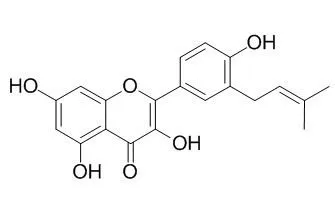Previous collaborative work by our group has led to the discovery of several plant isolates and derivatives with activities in in vivo models of cancer chemoprevention, including deguelin, resveratrol, bruceantin, brassinin, 4'-bromoflavone, and oxomate.
METHODS AND RESULTS:
Using a panel of in vitro bioassays to monitor chromatographic fractionation, a diverse group of plant secondary metabolites has been identified as potential cancer chemopreventive agents from mainly edible plants. Nearly 50 new compounds have been isolated as bioactive principles in one or more in vitro bioassays in work performed over the last five years. Included among these new active compounds are alkaloids, flavonoids, stilbenoids, and withanolides, as well as a novel stilbenolignan and the first representatives of the norwithanolides, which have a 27-carbon atom skeleton. In addition, over 100 active compounds of previously known structure have been obtained. Based on this large pool of potential cancer chemopreventive compounds, structure-activity relationships are discussed in terms of the quinone reductase induction ability of flavonoids and withanolides and the cyclooxygenase-1 and -2 inhibitory activities of flavanones, flavones and stilbenoids. Several of the bioactive compounds were found to be active when evaluated in a mouse mammary organ culture assay, when used as a secondary discriminator in our work.
CONCLUSIONS:
The compounds (2 S)-abyssinone II, (2 S)-2',4'-dihydroxy-2"-(1-hydroxy-1-methylethyl)dihydrofuro[2,3- h]-flavanone, 3'-[gamma-hydroxymethyl-( E)-gamma-methylallyl]-2,4,2',4'-tetrahydroxychalcone 11'- O-coumarate, Isolicoflavonol, isoliquiritigenin, and ixocarpalactone A are regarded as promising leads as potential cancer chemopreventive agents. |






 Cell. 2018 Jan 11;172(1-2):249-261.e12. doi: 10.1016/j.cell.2017.12.019.IF=36.216(2019)
Cell. 2018 Jan 11;172(1-2):249-261.e12. doi: 10.1016/j.cell.2017.12.019.IF=36.216(2019) Cell Metab. 2020 Mar 3;31(3):534-548.e5. doi: 10.1016/j.cmet.2020.01.002.IF=22.415(2019)
Cell Metab. 2020 Mar 3;31(3):534-548.e5. doi: 10.1016/j.cmet.2020.01.002.IF=22.415(2019) Mol Cell. 2017 Nov 16;68(4):673-685.e6. doi: 10.1016/j.molcel.2017.10.022.IF=14.548(2019)
Mol Cell. 2017 Nov 16;68(4):673-685.e6. doi: 10.1016/j.molcel.2017.10.022.IF=14.548(2019)